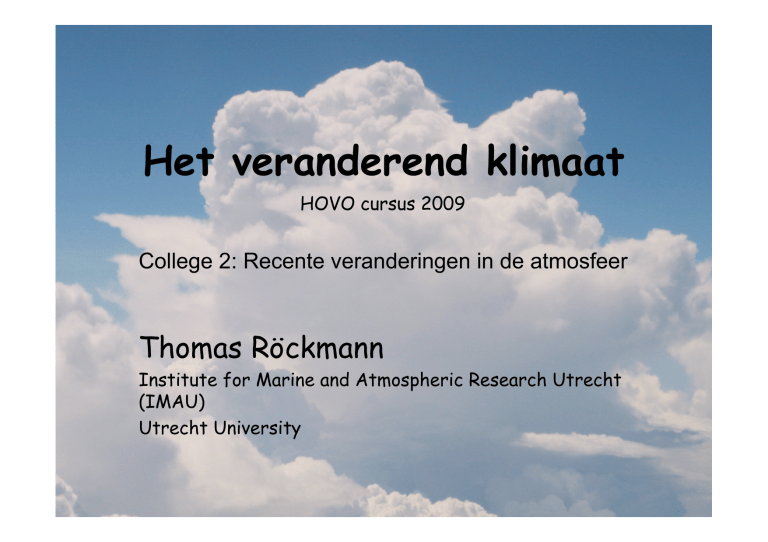
Het veranderend klimaat
HOVO cursus 2009
College 2: Recente veranderingen in de atmosfeer
Thomas Röckmann
Institute for Marine and Atmospheric Research Utrecht
(IMAU)
Utrecht University
Atmosfeer en klimaat
HOVO cursus 2009
Natuurlijke en mens-gemaakte veranderingen in de atmosfeer
De koolstofcyclus
De stijging van CO2 en andere gassen in het 20e eeuw
Het “anthropoceen”
NEEM pictures
Temperature and trace gases from ice cores
IPCC, 2007
Temperatur und Spurengase II
IPCC 2001
CO2 in the past
From IPCC 2007
A simple view of the Carbon cycle
Units:
Reservoirs PgC (1015 gC)
Atmosphere
760 PgC (~380 ppm)
Fluxes PgC per year
Fossil fuels
4000 PgC
6
plant
soil
respiration
plant
assimilation
gas exchange
60
60
120
90
Biosphere
plants 600 PgC
soils 1600 PgC
90
Ocean
surface 1000 PgC
deep 38000 PgC
Eerste stap: Nauwkeurige waarnemingen
Tweede stap: Verklaring, begrip van het systeem
->onderzoek naar globale kringlopen/budgetten
http://cdiac.esd.ornl.gov/trends/emis/tre_glob.htm
Global measurement network
CO2 rug
Waarnemigen in de atmosfeer
Stijging: ~30 ppb in 20 jaren
1.5 ppb/yr
3 PgC/y
“Airborne fraction”
Emissies van fossiele brandstoffen
2 keer groter dan atmosferische stijging
From IPCC 2007
Waar zijn de emissies?
Op het noordelijke halfrond!
From IPCC 2007
Koolstof isotopen
+
6 protonen
6 neutronen
12C
7 neutronen
13C
+
6 protonen
2 extra neutronen: 14C, radioactief
Isotope effects
CO2
12CO
2
13CO
2
CnH2nOn
13CC H O
n-1 2n n
is assimilated
faster than 13CO2
13CO
2
is depleted in the
plant by about 2%
Fossil material has no
14C
13C
observations
Extra CO2 is not from the ocean!
Sources: Friedli (1986), Francey (1999 ), and ESRL & INSTAAR, from P. Tans, NOAA/GMD
14
Δ C
observations
atmosphere
upper ocean
Extra CO2 is not modern!
from P. Tans, NOAA/GMD
CONCLUSIES
Biosphere
source
Ocean
source
Anthropogenic
source
Size of reservoirs
-
?
+
Size of fossil emissions
(airborne fraction 50%)
-
-
+
Interhemispheric gradient
?
-
+
δ13C
+
-
+
14C
-
?
+
Variability in 650.000 years
-
-
+
De stijging van CO2 is (~)100% anthropogeen
Global CO2 cycle
Units: PgC (1015 gC) and PgC per year
fossil fuel
burning
plant
soil
respiration
landuse
plant
assimilation change
Atmosphere 750
increase: 3
gas exchange
120 + 3?
60
2?
6
90
60
Rivers
Fossil fuels
5000-10000
Biosphere
2200
plants 600, soils 1600
92
1
Surface ocean 1000
increase: 1
Deep ocean 38000
increase: 1
from I. Levin, IUP Heidelberg
Sediments
0.2
Changes to the atmospheric CO2 budget
IPCC 2007
Nog twee voorbeelden
Het gemiddelde EU-Auto produceert 160 g CO2/km
-> als je 10 km rijdt wordt zo veel CO2
geproduceerd dat de hele
atmosferische kolom boven 1cm2
aardoppervlakte 100% vol zit met CO2
-> Als je tussen de 6 en 10 keer je auto voltankt
produceer je net zo veel kg CO2 als je auto weegt
The CO2 climate forcing is 1.7 W/m2
1) The global energy consumption today is 0.03 W/m2
2) CO2 climate forcing
provides more energy each
year than has EVER been
produced from fossil fuels in
the 250 years since the
industrial revolution.
This enormous amount of
energy is bound to impact the
climate system.
Methaanstijging
The last 20 years
Bron: NOAA/CMDL, Boulder, en Etheridge et al., 1998
Sources and sinks of atmospheric CH4
1990 – 2000
Senken [Tg / yr]
Quellen [ Tg / yr ]
Sources
[Tg/yr]
Total~ 600 Tg(CH /y)
Sinks [Tg/yr]
4
Biomass
Biomassen
burning
Verbrennung
40-66
Natürliche
Quellen
Natural sources
Transport to
in
Transport
stratosphere
Stratosphäre
39-49
12-31
Oxidation
Oxidation
insoils
Böden
in
175-242
RiceReisfelder
paddies
wetlands
termites
Ocean
hydrates
90-120
Wiederkäuer
Ruminants
92-140
Mülldeponien
Domestic
waste
36-48
Energie
Energy
90-110
troposphärisches
Tropospheric
OH OH
499-558
Atmospheric life time ~ 10 years
Changes to the atmospheric CH4
budget
IPCC 2007
Identification of the “modern” N2O source
today
present trend: +0.8 ppb/yr
pre-industrial
Changes to the atmospheric N2O budget
IPCC 2007
Broeikasgassen en stralingsbalans
IPCC bericht 2007
CO2
CH4
Bron: IPCC 2007
N 2O
The anthropocene
Paul Crutzen, Nobel Price for Chemistry 1995
Most cited author in Geosciences 2002
“Since the beginning of the 19th Century, by
its own growing activities, Mankind opened a
new geological era:
the Anthropocene
Man is clearly affecting climate and is even
able to deliberately do so.”
Human population and related changes
• During the past 3 centuries human population has increased
tenfold to >6000 million and fourfold in the 20th century
• Cattle population increased to 1400 million (one cow/family); by
a factor of 4 during the past century
• Urbanisation grew more than tenfold in the past century; almost
half of the people live in cities and megacities
• Industrial output increased 40 times during the past century;
energy use 16 times
• Almost 50 % of the land surface has been transformed by
human action
• Water use increased 9 fold during the past century to 800 m3
per capita; 65 % for irrigation, 25 % industry, ~10 % households
The great acceleration
New Scientist



